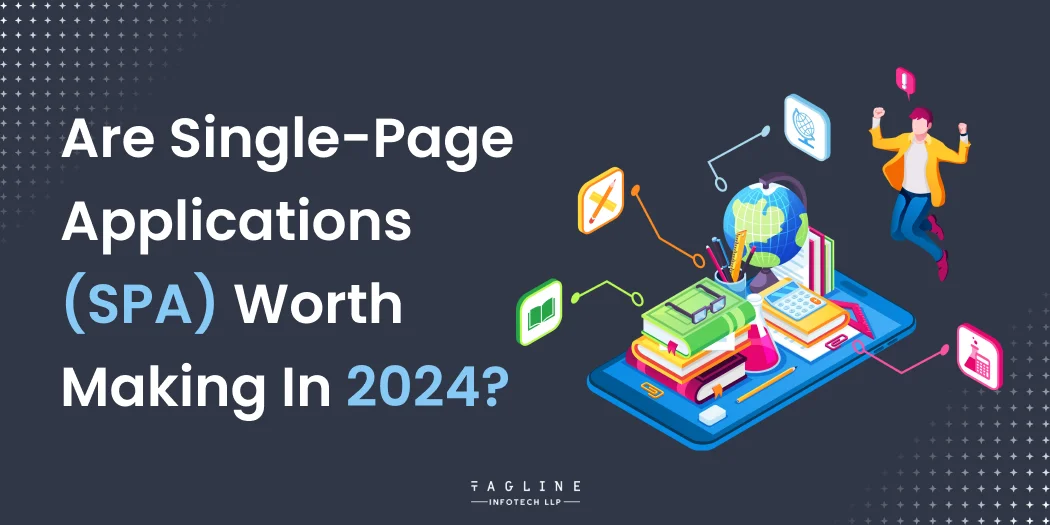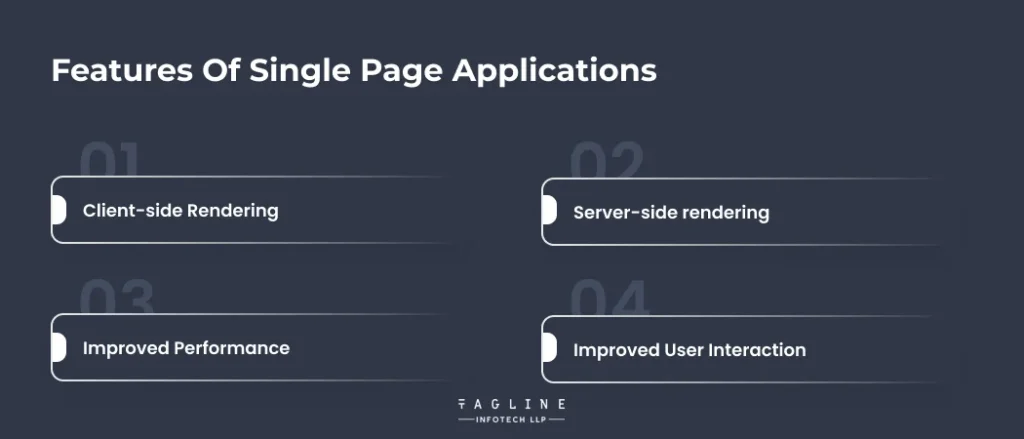Role of Python Libraries in Image Processing
October 30, 2025
Home >> DevOps >> Are Single-page Applications(SPA) Worth Making in 2024?

Quick Summary
A single-page application, sometimes called a web application or website, loads just one page. When the user interacts with the page, it is updated with new content retrieved from a web server. This eliminates the need for the user to load a new page after every interaction.
A single-page application is a website development solution that displays JavaScript code directly in the browser. It guarantees that users will never have to reload any pages when they navigate the website. This can be accomplished in one of two ways: by ensuring the browser obtains the required HTML, JavaScript, and CSS codes in a single request or by updating the required content in reaction to the user’s actions.
Organizations are adopting single-page apps (SPA) more frequently due to their simple architecture, intuitive navigation, and low resource usage. This is because single page application sites process data more efficiently and affordably than standard multi-page application (MPA) websites. Moreover, these websites require less time to design because they employ repeated layouts.
The advantages of single page applications (SPAs) include processing efficiency gains, potential cost savings over standard multi-purpose award websites (MPA websites), and reduced development effort due to the ability to use repeating layouts and operate as “content on demand” applications.
MPAs send out server requests continuously, and when they get them, they are handled like a database query. After getting a response from the database, the server responds by processing the query, and then the pages are shown. There’s too much patty-caking, which makes the website load slower.
Contrarily, how does single page application work? SPA websites download everything simultaneously, removing the need for back and forth. Instead of requiring the site’s architecture to request more HTML pages, new content is loaded as a single page. With JSON’s help, speeds and efficiency may be increased; as a result, users will be able to quickly access all of the website’s features and functionalities without having to wait.
With single page apps (SPAs), it is often possible to navigate between pages more quickly due to caching (more on that in a moment) and fewer data amounts. The application merely downloads the missing portions; even if a user needs the submitted data, only the necessary data is exchanged back and forth. Consequently, the entire process is more efficient compared to MPAs, which load pages upon request.
Data is only requested from the server once, during the initial download, for single-page applications (SPAs). This increases the effectiveness of caching since site data can still be retrieved by the server if connection circumstances improve, even if a user has a bad internet connection.
It’s also crucial to remember that, even if the SPA serves as a landing page and the browser only downloads the information once, it will eventually check to see if the cached data has changed. An application will obtain something asynchronously as soon as it is changed.
Programs that are single-page in nature also offer a better overall user experience. Users of an SPA merely need to scroll down the page to find the information they’re looking for, but users of an MPA must go through some links and menus. SPAs are especially well-suited to scenarios that are mobile because of this feature.
Additionally, while utilizing an SPA, a user can browse a page even with a weak internet connection, and interacting with an SPA is typically simpler from any device. The experience is continuous because there’s no need to reload the page. The fact that page elements are reused also makes navigation more effective overall.
The initial loading process takes a lot longer with SPAs because a lot more JS is used in them. Furthermore, a mobile browser can significantly slow down the loading of an application because it needs to read and comprehend the JavaScript data. This is particularly valid in cases where the smartphone’s processor isn’t powerful.
Another challenge is that SPAs affect the precision and value of statistics that track website visitors. Deciding which sites or content are the most popular can be difficult when you only have one page. This is because it cannot be compared to any other page. After all, there is no one to compare it to. Google Analytics is one example of this, as it collects data from each page downloaded from a website.
If you want to monitor the activity on a single-page application (SPA), you will have to manually adjust the default Google Analytics tag to track the page views.
“Common Challenges Faced in DevOps “
– Also Read Article

In client-side rendering, the browser requests an HTML file from the server. The browser gets an HTML file from the basic server with scripts and styles attached. The user will see a blank page or a graphic that loads the page when JavaScript is performed. Retrieving data, creating views, and injecting the data into the Document Object Model (DOM) are all handled by the Service Provider (SPA). The SPA is then finished and prepared for use.
Regarding the three options, CSR usually takes the longest to finish and might occasionally overload the browser because it uses many device resources when showing material. Furthermore, customer service representatives (CSRs) might be a good option for websites with a lot of traffic because they can give clients information without using a lot of server connectivity, which makes the user experience faster.
Browsers request an HTML file to the server during server-side rendering. After that, while the application executes, the server gathers the required information, renders the SPA, and creates the HTML file. After that, the user is provided with accessible content. The SPA architecture is needed for tasks like attaching events, creating a virtual document object model (DOM), and performing other operations. The SPA is then finished and prepared for use.
By combining the speed of a single-page application (SPA) with the feature of not overloading the user’s browser, SSR adds to the program’s speed.
SPAs provide several performance advantages over standard multi-page websites, such as the following:
Traditional web pages are typically crawled and indexed by search engines, which makes search engine optimization (SEO) challenging for SPAs. On the other hand, modern methods like server-side rendering (SSR) or pre-rendering can help SPAs become more search engine optimization (SEO) friendly. This guarantees that search engines can appropriately index and rank the application’s content.
Elevate your web experience with Single Page Applications (SPAs)!
Hire a Ruby on Rails developer now to explore the potential of Single-page Applications (SPAs)
An online platform that facilitates streaming and entertainment. The React framework, on which Netflix is based, ensures that users’ experiences watching content are uninterrupted by delayed content. With a SPA technique, Netflix can simultaneously send enormous volumes of data to numerous site users. With each new request a viewer makes, Netflix puts new content straight into the browser, which accounts for its speed.
Gmail is a single-page application; clicking on an email in your inbox doesn’t require you to refresh the page. This occurs as a result of the server loading all data simultaneously. Regarding Calendar and Google Drive, the same applies.
Grammarly is a real-time online writing tool that assesses your spelling and punctuation. This is partly caused by artificial intelligence (AI), SAP’s advanced capabilities, and its construction on a Vue.js framework. As a result, users can receive real-time suggestions from Grammarly directly on Google Docs; these suggestions are meant to improve the readability, accuracy, and clarity of the user’s writing.
Single-page applications are the next development in the ongoing evolution of app experiences. They are quicker and easier to use than conventional techniques, and they can be combined with sophisticated features like customization. This is the rationale behind the single-page architecture used by the most popular websites with massive concurrent user bases, including Gmail, Netflix, or Facebook’s news feed. If businesses use this technology, they can boost the value of their websites and gain new ground as digital firms. By doing so, your business can not only enhance the value of its online presence but also stay ahead in the competitive digital landscape. Hire a DevOps Developer to embark on a journey towards optimized performance and elevated user satisfaction.
Yes, Single Page applications are worth it because they have better speed and responsiveness. Faster loading time is one of the main functionalities of these SPAs and the main reason why they are popular among users.
You should think about creating a Single Page Application (SPA) whenever you are trying to have a solution with user-friendly interfaces that can become popular among the users.
Created with Solvase

Digital Valley, 423, Apple Square, beside Lajamni Chowk, Mota Varachha, Surat, Gujarat 394101
D-401, titanium city center, 100 feet anand nagar road, Ahmedabad-380015
+91 9913 808 2851133 Sampley Ln Leander, Texas, 78641
52 Godalming Avenue, wallington, London - SM6 8NW